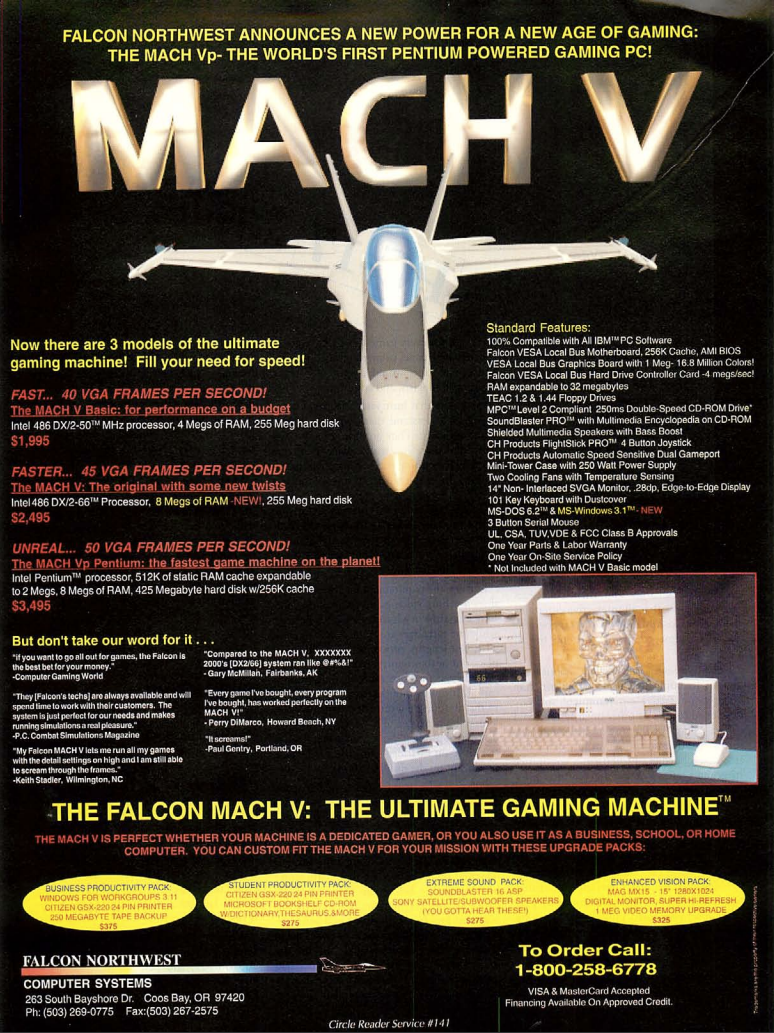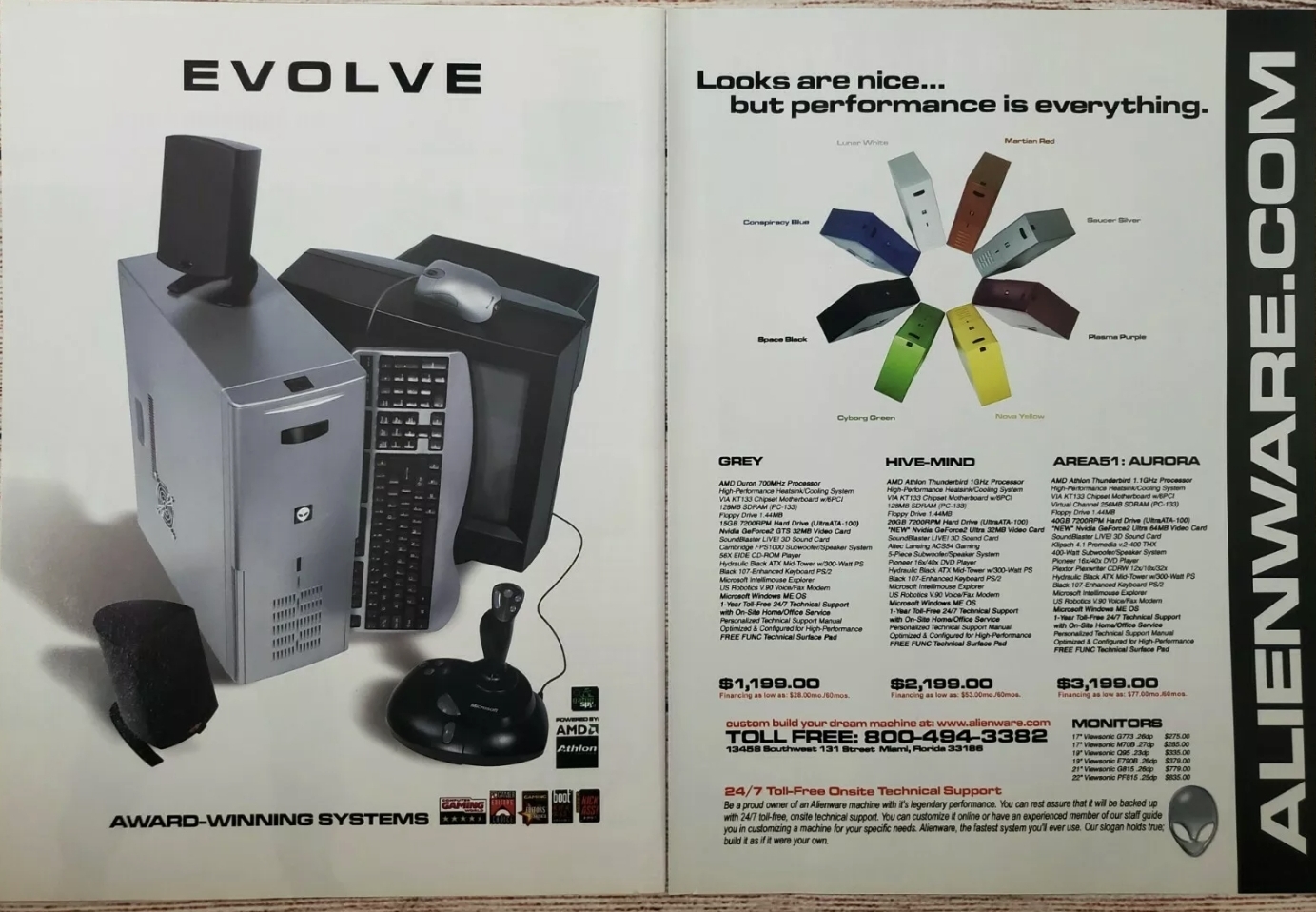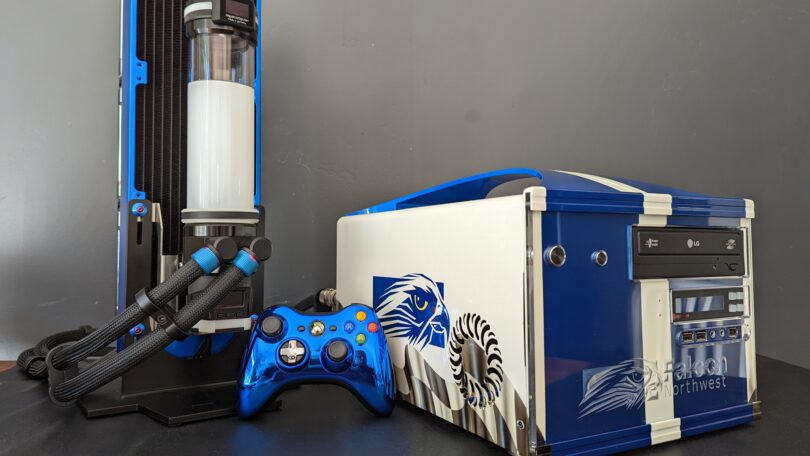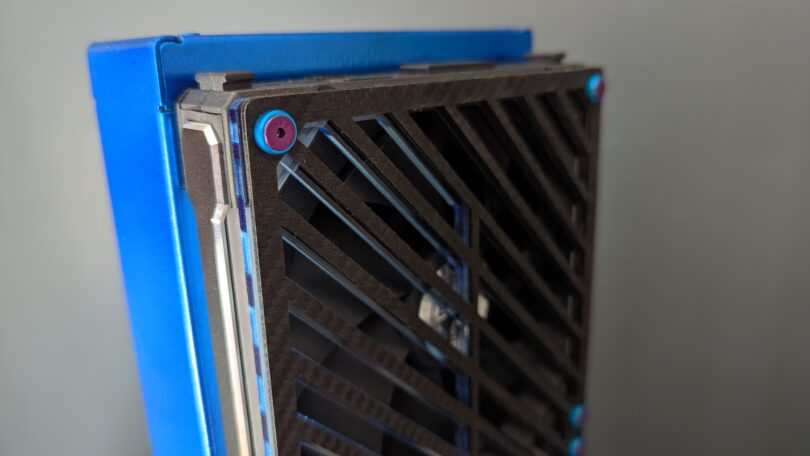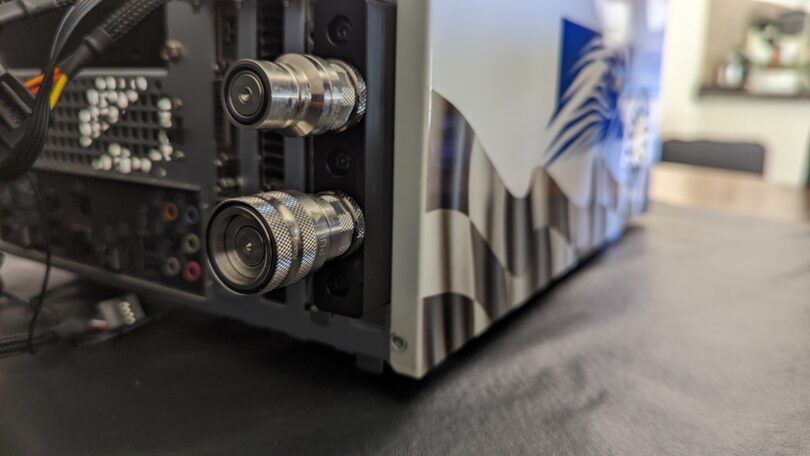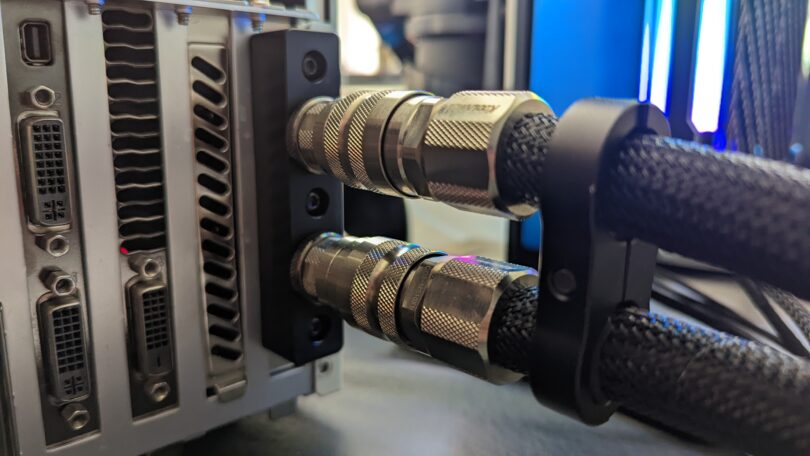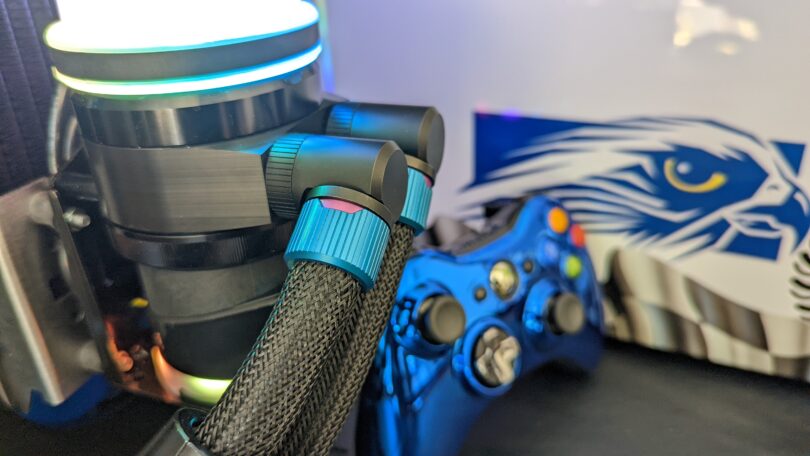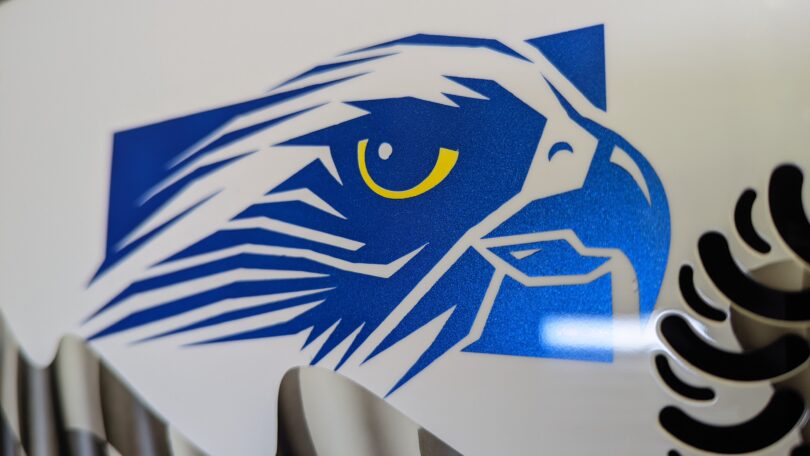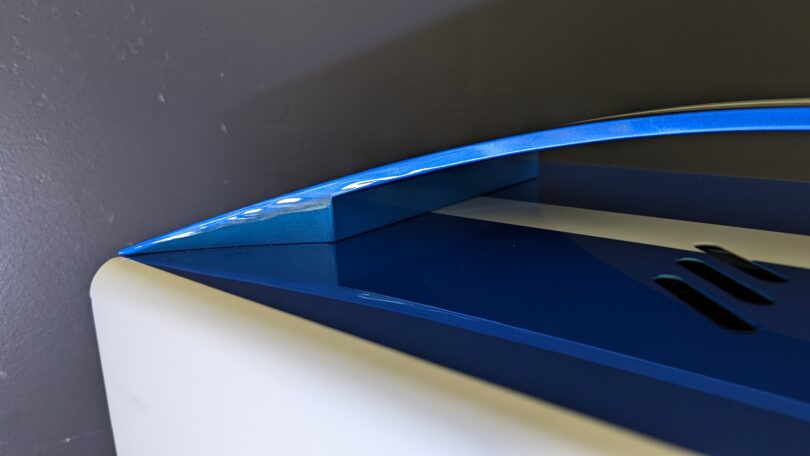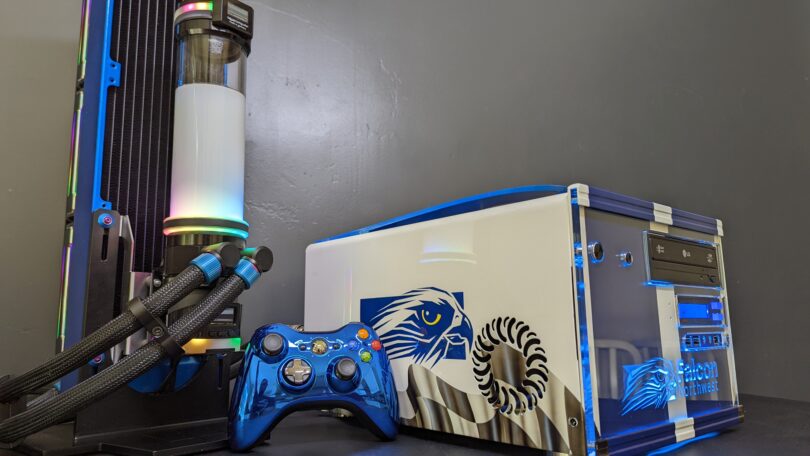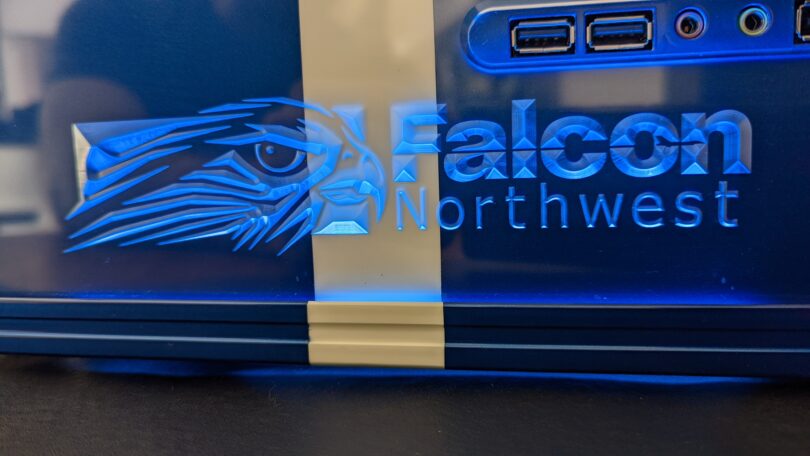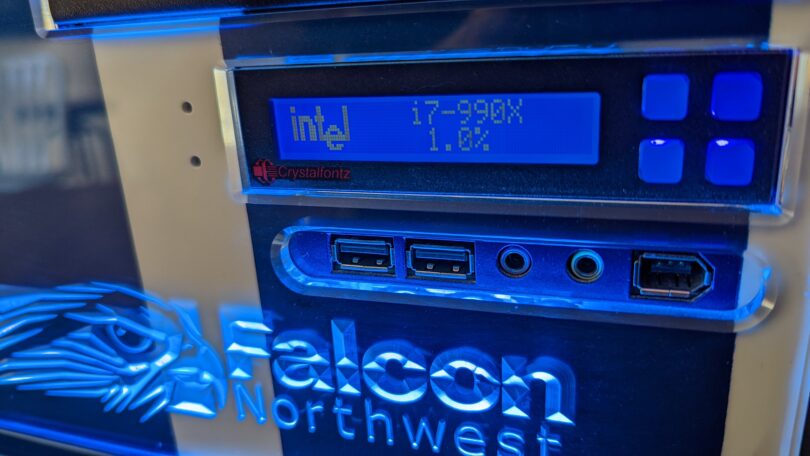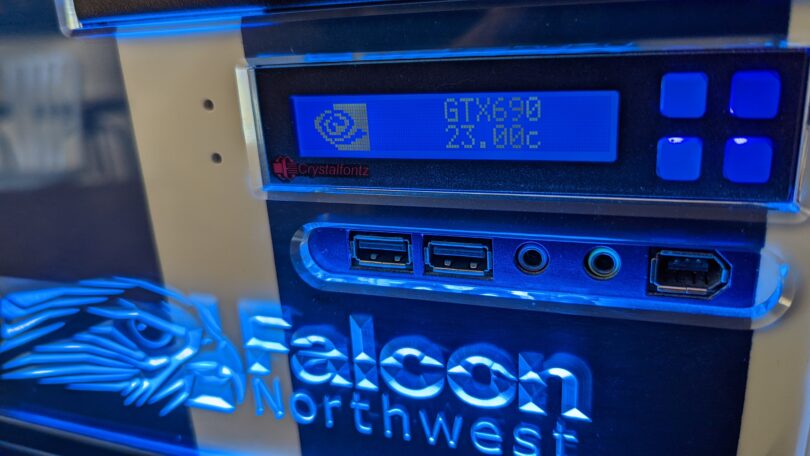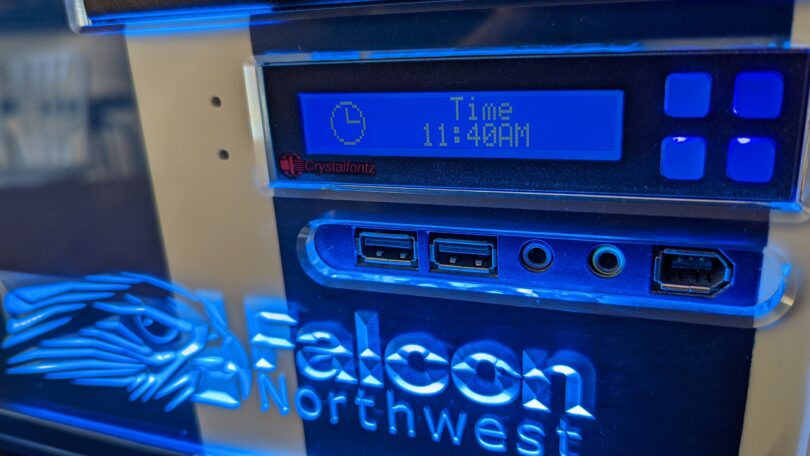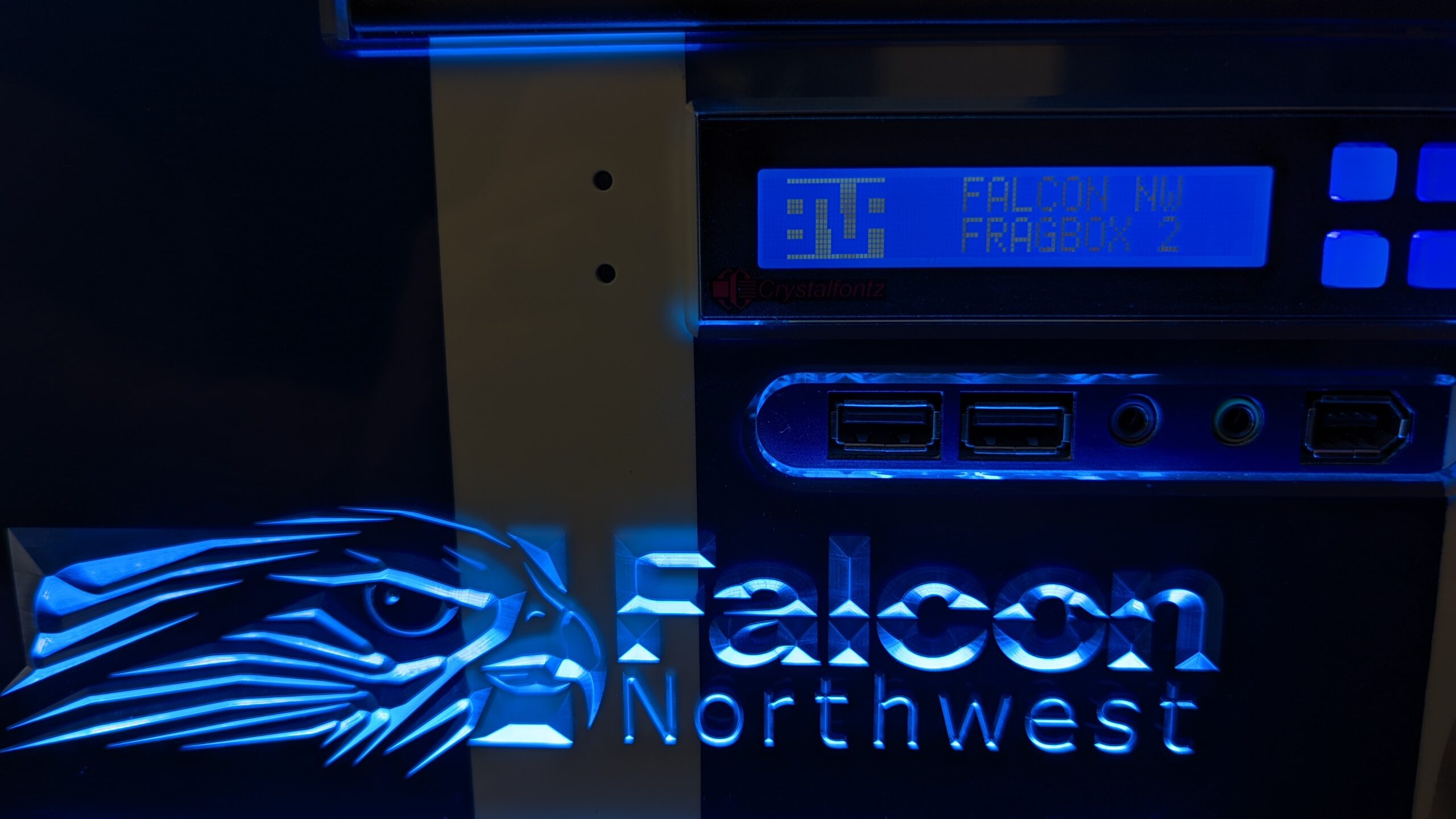This has been an article 6 months in the making. It was a lot of fun to research and cover the history of a hobby that’s so near and dear to all of us, but that joy paled in comparison to building inside an actual Falcon Northwest FragBox 2 chassis that I get to call my own. To that end, we’re happy to celebrate Falcon Northwest’s 30th anniversary this month and we’re thankful that we got to host a Q&A from their founder and CEO, Kelt Reeves.
Table of Contents
The History of SFF
While some computer historians may argue, Small Form Factor computers as we know it have been around for just over 30 years, starting with Steve Job’s NeXTCube ($7,995, $17,355.08 in 2022 dollars) at 28.37 liters and the NeXTStation ($4,995, $10,842.86 in 2022) at 9.29 liters, both of which were released to consumers in 1990. These days, most of us would scoff at the idea of owning any chassis that was over 20 liters in a size, but to understand how we got here, we first need to understand that gaming computers had a very different size back in the ’90s, and that “Small Form Factor” wasn’t even a label that could be applied to the size of a desktop computer. In fact, SFF as we know it, originally stood for “Shuttle Form Factor” (also SFF), coined by Shuttle Computer Group with the release of their SV24 chassis in 2001, which was the worlds first commercially successful Small Form Factor computer. It wasn’t until companies like AOpen and First International Computer later replaced the word “Shuttle” with “Small” in their marketing materials, did that evolve into its modern-day definition. However, while these facts are pretty well documented, the actual timeline for small form factor gaming computers remains cloudy, as the world never bothered to chronicle how modern SFF gaming computers really came to be. To help make sense of it all we look to Falcon Northwest, a company that has widely been credited as the father of pre-built gaming PCs. Get ready for one epic nostalgia trip and be sure to stick around for the Q&A at the end!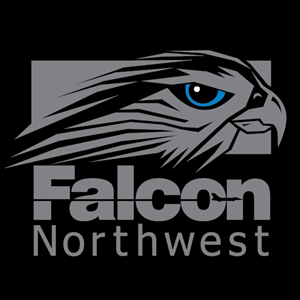
SFF Bullet Points
| 1993 | Falcon Northwest pioneered and introduced the pre-built gaming PC to the world. |
| 2000 | Apple released the 8” Power Mac G4 Cube at 9.77 liters. |
| 2001 | Shuttle released the barebones SV24 at 8.72 liters. |
| 2002 | Shuttle released a gaming capable barebones SS51 XPC at 10.13 liters. |
| 2003 | Arprotek, a division of Chyang Fun Industry, releases the barebones CF-S968L at 10.86 liters. |
| 2003 | First International Computer rebranded the barebones CF-S968L as the barebones FIC Ice-Cube IC-VG61 -marketed worldwide. |
| 2003 | Falcon Northwest released the FragBox, the first prebuilt SFF gaming computer, based on the FIC IC-VG61. |
| 2004 | The legendary FragBox 2, at 19.82 liters, was unleashed upon the world. |
30 years of Falcon Northwest
Let’s fill in a few more blanks shall we? Before SFF computing really came to fruition, especially SFF gaming, a visionary (some might even call him a gentleman), by the name of Kelt Reeves, founded a company called Falcon Northwest in April of 1992. At the time, Reeves was still attending Embry-Riddle Aeronautical University, where he built high-end computers for people to enjoy Microsoft Flight Simulator 4.0 with. In 1993, Reeves then introduced the very first pre-built gaming PC to the world, fittingly called the Mach V, at a time when adults were ashamed to admit using their personal computers for gaming.
Fast forward to 1996 (one of the peak years for LAN parties thanks to Quake) and Falcon Northwest’s first real competitor emerged on the national scene; Alienware.
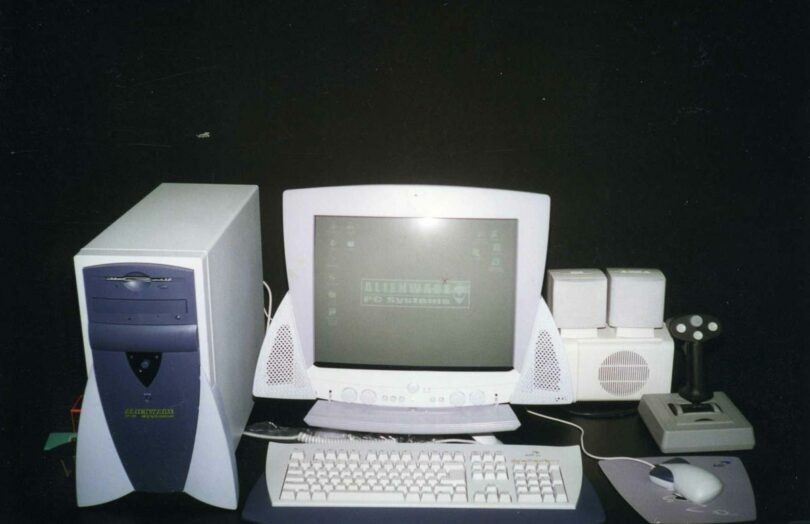
In 2000, Alienware revolutionized the look of gaming PCs by pushing case aesthetics, and even colors.
In 2002, Falcon Northwest raised the bar with the Mach V Exotix that utilized the Cooler Master ATC-110 chassis (50.75 liters) with 10 layers of base coats, colors, tints, and clearcoats. If you wanted your computer painted to match the exact color of your 1999 Dodge Viper GTS, their award winning certified master tech, with over 20 years of auto painting experience (at the time), could make it happen. Not only did Falcon Northwest manage to steal Alienware’s thunder in a big way, but Falcon Northwest’s lust worthy Exotix paint jobs were the desire of every PC gamer, all while producing some of the fastest gaming PCs in every head-to-head battle, for years to come.
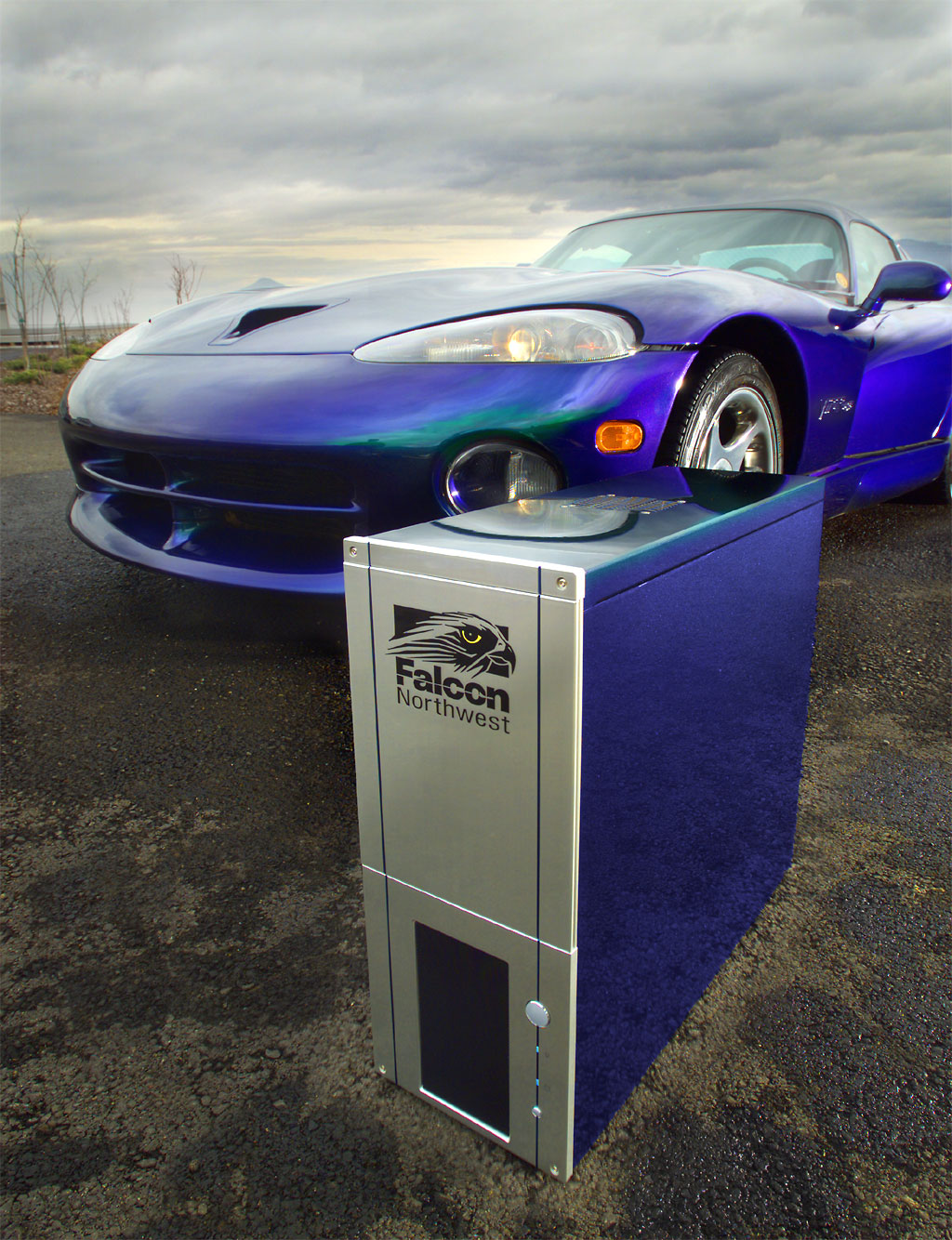
In 2003, Alienware released their first in-house designed Predator chassis at a whopping 82.66 liters.
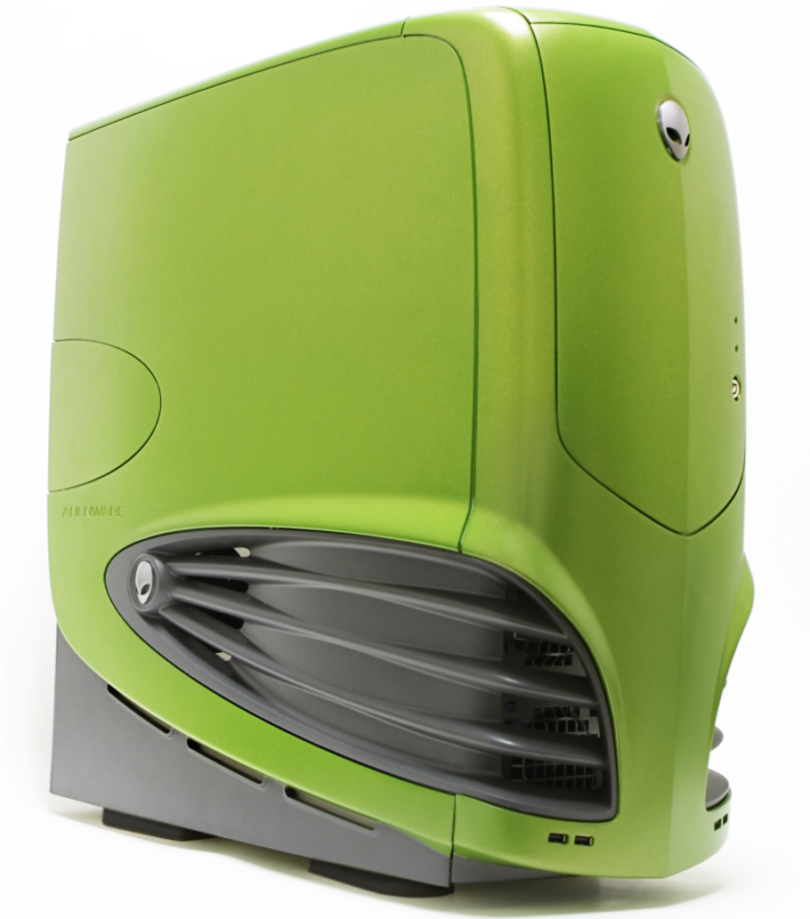
While the Area-51 ALX desktops were getting bigger, Reeves had seen the interest that Shuttle had garnered with their 8.72 liter SV24 (released in 2001), and wanted Falcon Northwest to give LAN-goers a portable PC with the power of a desktop.

In 2003, Falcon Northwest then completed the 10.86 liter FIC Ice Cube IC-VG61 chassis to become the original FragBox, winning PC of the Year from Ziff Davis magazines alongside several Editor’s Choice awards.
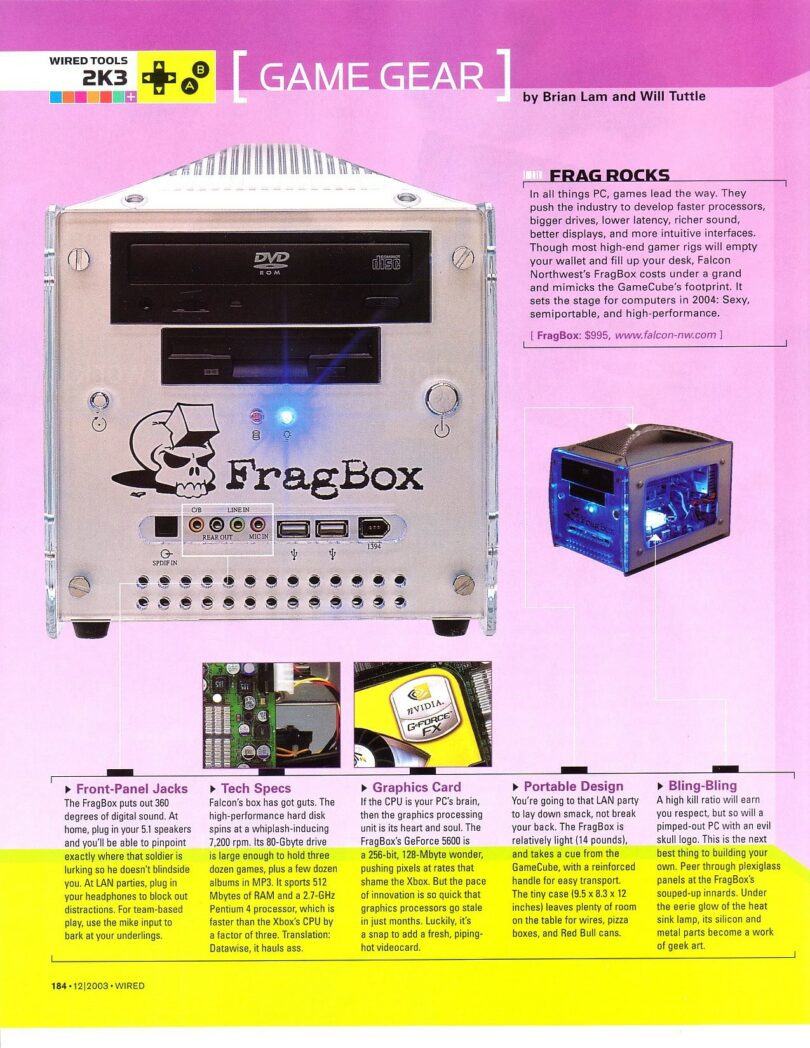
Not content with the limitations of the Chyang Fun 220watt PSU as well as the Chyang Fun CF-S96 motherboard that included a mid-range Intel 845GE chipset, Reeves then designed and commissioned a case to be built by a startup in the case industry; SilverStone (founded in 2003). The goal for this in-house designed chassis was that it could fit off-the-shelf PC parts and so the legendary FragBox 2 went on to make its official debut in 2004. As some of you may recall, SilverStone later sold a variant of this case in 2005 without the FragBox’s iconic handle. That case was SilverStone’s very first Sugo chassis, the SG-01, and we have Falcon to thank for its design. For the first time in the history of SFF gaming, system builders like you and I finally had access to a blank canvas SFF chassis who’s only limits were the depth of our wallets and the height of our heat sinks —a tale we’ve become all too familiar with.
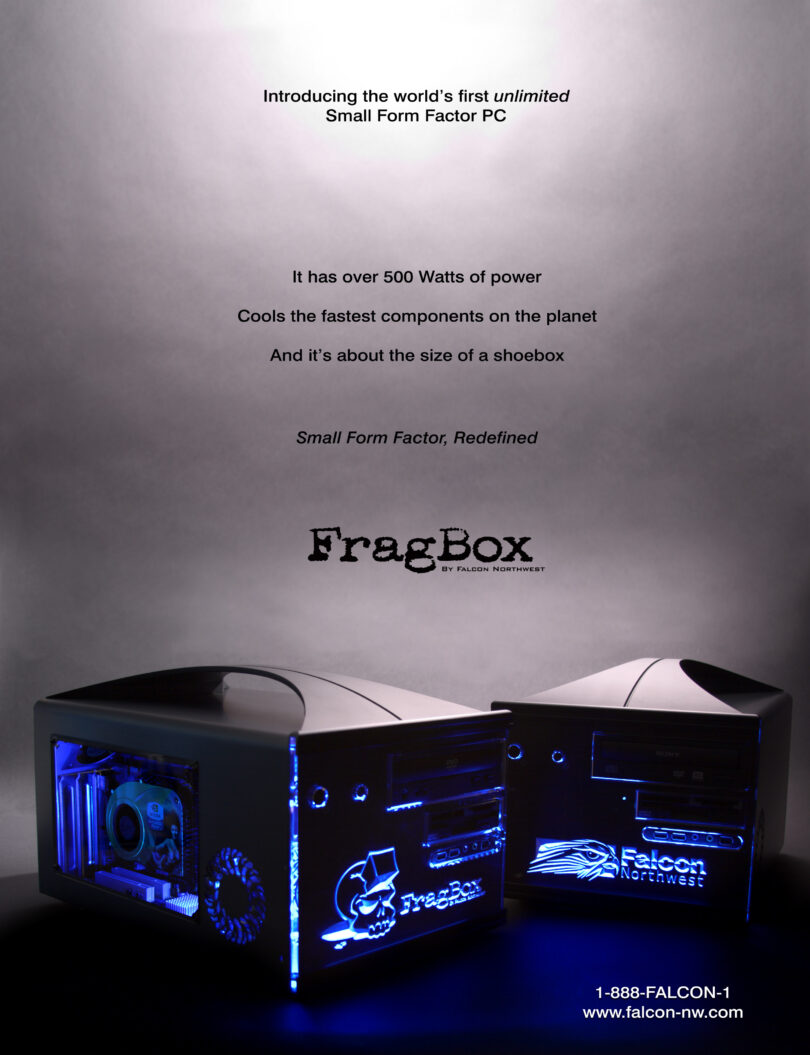
With all that history behind us, I’m pleased to share that Falcon Northwest will be celebrating their 30th anniversary this month, with the iconic FragBox celebrating its 20th anniversary next year, and the Tiki celebrating its tenth anniversary in June. As the true pioneer of pre-built gaming PCs, and even SFF gaming PCs, we owe a great deal of respect to the team at Falcon Northwest for driving innovation. To help celebrate this momentous occasion, I reached out to Falcon Northwest CEO, Kelt Reeves, and asked if he would be willing to take a few questions. Not only did he welcome the opportunity, but Reeves was also extremely generous, and shipped me my very own FragBox 2 with an Exotix paint job. The whole thing was serendipitous as Reeves had no idea that I raced cars and that I am an automotive racing enthusiast, so imagine my surprise when I opened the box to see a checkered flag paint job.
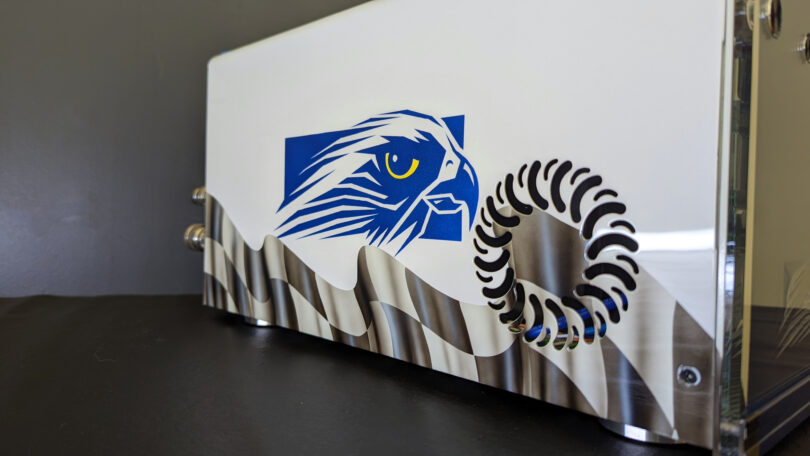
Being that no two Exotix paint jobs are alike, mine appears to be the exact case that was reviewed by PCMag in October 2010, as a similarly painted case that was reviewed in the May 2009 issue of Maximum PC magazine had a few noticeable differences.
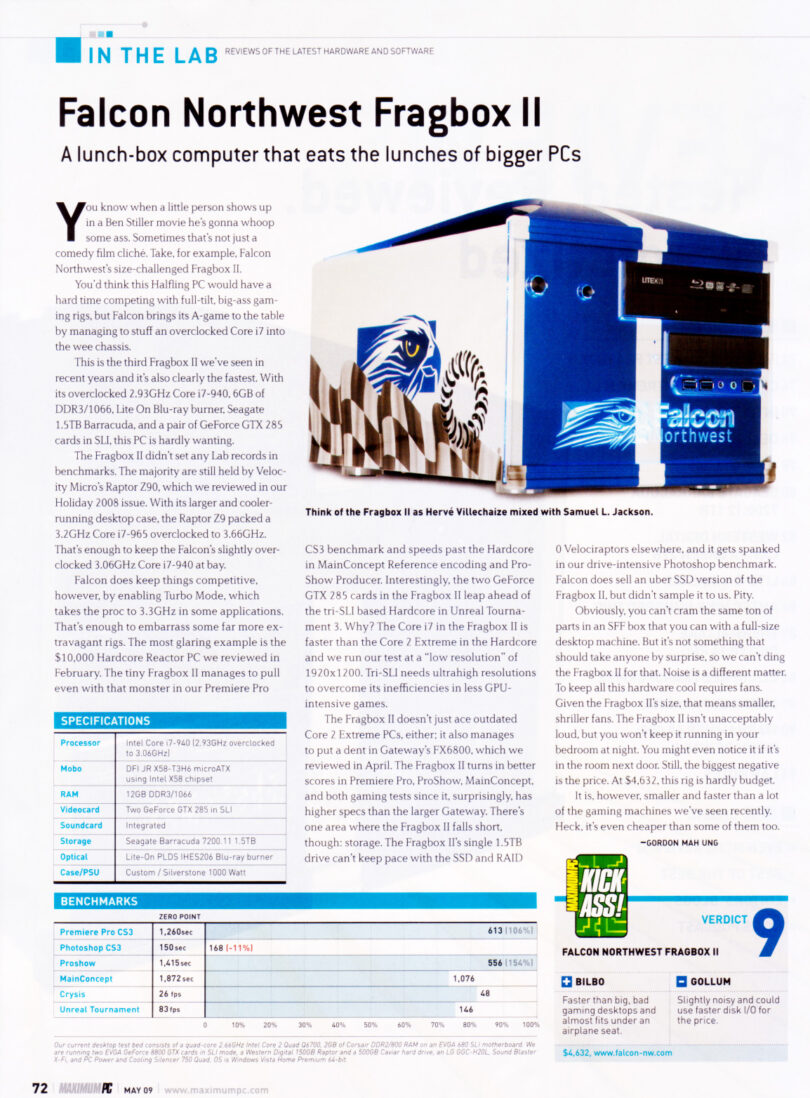
While the FragBox 2 could be configured for as little as $2000 at the time, the version PCMag reviewed was configured to a staggering $8,895 (~$11,763 with today’s inflation). With the paint job option asking $800, an additional $3200 price hike came from the inclusion of four 256GB Samsung 2.5” SSDs in a Raid 0 configuration. I did a little sleuthing around and this was the included hardware, to the best of my knowledge.
– 2008 Intel i7-965 Extreme Edition (4c/8t. @ 3.2 GHz, 45nm Bloomfield)
– 2009 DFI LANPARTY JR X58-T3H6 X58 Micro ATX motherboard
– 2008 2x Nvidia GeForce GTX 285
– 3x 4GB of DDR3 1066 ram
– 4x 256GB 2.5” Samsung SSD
– 1200 watt SilverStone PSU
3lfk1ng’s Falcon Northwest FragBox 2
While all that nostalgic hardware looks gorgeous on paper, the FragBox 2 that Falcon Northwest had sent me arrived empty, even missing the original fan mounting brackets. While I could have taken the easy(and more affordable) route by throwing in an AMD APU, I decided instead to build a near-period correct gaming PC that could play yesteryear’s PC games without any potential compatibility issues. Like restoring an old Porsche to “better than new” condition, I spared no expense to create the most flagship, somewhat period-correct, retro PC imaginable, just as the world has come to expect from a Falcon Northwest PC. Before anyone starts to question my hardware choices below, just know that it was important that I stick with Intel’s socket 1336 as that was synonymous with the release of this particular chassis. I also happened to have the first “Crysis capable” EVGA GTX 690 Hydro Copper Signature Edition graphics card just laying around.
– 2011 Intel i7-990X Extreme Edition (6c/12t, @3.73 GHz, 32nm Gulftown)
– 2010 ASUS Rampage III Gene X58 Micro ATX motherboard
– 2012 EVGA GeForce GTX 690 Hydro Copper Signature Edition (2x NVIDIA GTX680 on a single PCB)
– 3x 4GB of DDR3 1600 ram
– 2x 1TB 2.5″ Samsung SSD
– 600 watt Corsair SF600 PSU
To keep temperatures in check and noise levels to a minimum, the system is being cooled by an external radiator setup using Koolance QD3 quick disconnects and an Alphacool PCI Pass-through at the rear of the chassis. This setup features a custom painted 560mm EK radiator, mounted to a LiquidHaus 140mm vertical base, complete with Aquacomputer D5 Next hardware, a Heatkiller IV Pro waterblock, EK torque fittings, McMaster-Carr matte black tubing, MDPC sleeving, and 4x 140mm Lian-Li UNI fans. To top it all off, I even added the special edition Chrome Blue Xbox 360 controller, and a 3.5” CrystalFontz CFA631 LCD display —an accessory that Reeves later informed me that they used to sell on their website.
Q&A with Falcon Northwest’s Founder and CEO, Kelt Reeves.
Thank you so much for taking the time to connect Kelt, we really appreciate it. You’re somewhat of an icon for a great deal of us that grew up reading PC magazines and while several competitors have come and gone, Falcon Northwest is now celebrating its 30th anniversary as an indie PC vendor. For that, we want to give you and your team at Falcon Northwest congratulations and ask how it feels to look back at 30 years of accomplishments?
Thanks so much for your interest Drew! Small Form Factors have always been a passion of mine so it’s great to see your site keeping the history of them alive. 30 years is a looong time in the tech industry, and it was fun just digging thru my archives for this article to see how far we’ve come. My focus is almost always in designing cases or improving cases that won’t actually go on sale for months, so while we’re currently working on the final prototype of the next FragBox, it’s been fun to look back at where that model started.
Out of all the custom projects that Falcon Northwest has even done, is there a design or project that really stands out as one of your favorites and if so, how did that project come to be?
Our desktop chassis designs are like my children, so it’s hard to say you have a favorite. But if pressed I’d say our Tiki SFF is the one I’m most proud of. It’s our smallest (11.6 liters) PC, and I designed that one before the components needed in terms of power supply and motherboards necessary to run top end equipment were actually on the market. To this day it’s our most demanding case, and supporting the two radically different cooling types on Nvidia’s latest GPUs was a monster engineering challenge. The comparatively larger (20 Liter) FragBox practically feels like an easy thermal environment by contrast.
A great majority of our readers are using boutique SFF computer cases that have been designed by members of our esteemed community. Have you had a chance to follow the boutique case market in recent years? If so, what are your thoughts as a case designer?
For 10 years I’ve had a spreadsheet with the sizes and hardware support of all of our SFF competition on it, and I recently had to update it for press for the new Tiki. I was really surprised at what had happened in the past 5 years to the SFF market. DIY SFF options have exploded, but the number of companies building pre-built SFFs has not only shrunk, but the ones that are available are generally much bigger. Tiki is the last of the original “micro-towers” designs, and unless you know of one I missed, the smallest pre-built SFF on the market that support full-size graphics cards.
Does Falcon Northwest have any plans to go smaller than the Tiki?
No, because there you have to start making real cuts to something and getting into proprietary hardware, or super-limited short GPUs. Tiki is about the minimum size you can make something that supports a full-size GPU and industry-standard Mini-ITX board. The new Intel DIY “Dragon Canyon” NUC at 8.4 liters is the biggest NUC ever. And even though it’s 27% smaller than a Tiki, it only achieved that by swapping a motherboard for a proprietary add-in card, and using laptop SO-DIMM memory. Proprietary usually means you won’t find upgrades for it in a few years, and that’s what we were trying to get away from in the first SFFs on the market all those years ago. You were still able to build with newer, faster parts in the FragBox 2, but try that with the FIC IceCube-based FragBox 1.
How has Falcon Northwest been impacted by the death of Crossfire and SLI? Has this caused Falcon Northwest to see clients spending more on customization or have you seen a lower overall system cost for enthusiast builds? The Talon chassis went through a slight redesign to accommodate taller graphics cards, has this impacted the design of other cases in your lineup?
Unfortunately GPUs got way more expensive during the pandemic and still to this day wholesale is well above the “MSRP”, so that hasn’t helped overall system costs. But we do still have customers that want multi-GPU, and that was one of the reasons we enlarged the Talon. The new 3090 Ti has some board designs that are almost 4 slots deep, so one GPU is almost taking the space of two these days. It takes a new design with space below the motherboard open to allow 6-slots of GPU to be able to breathe.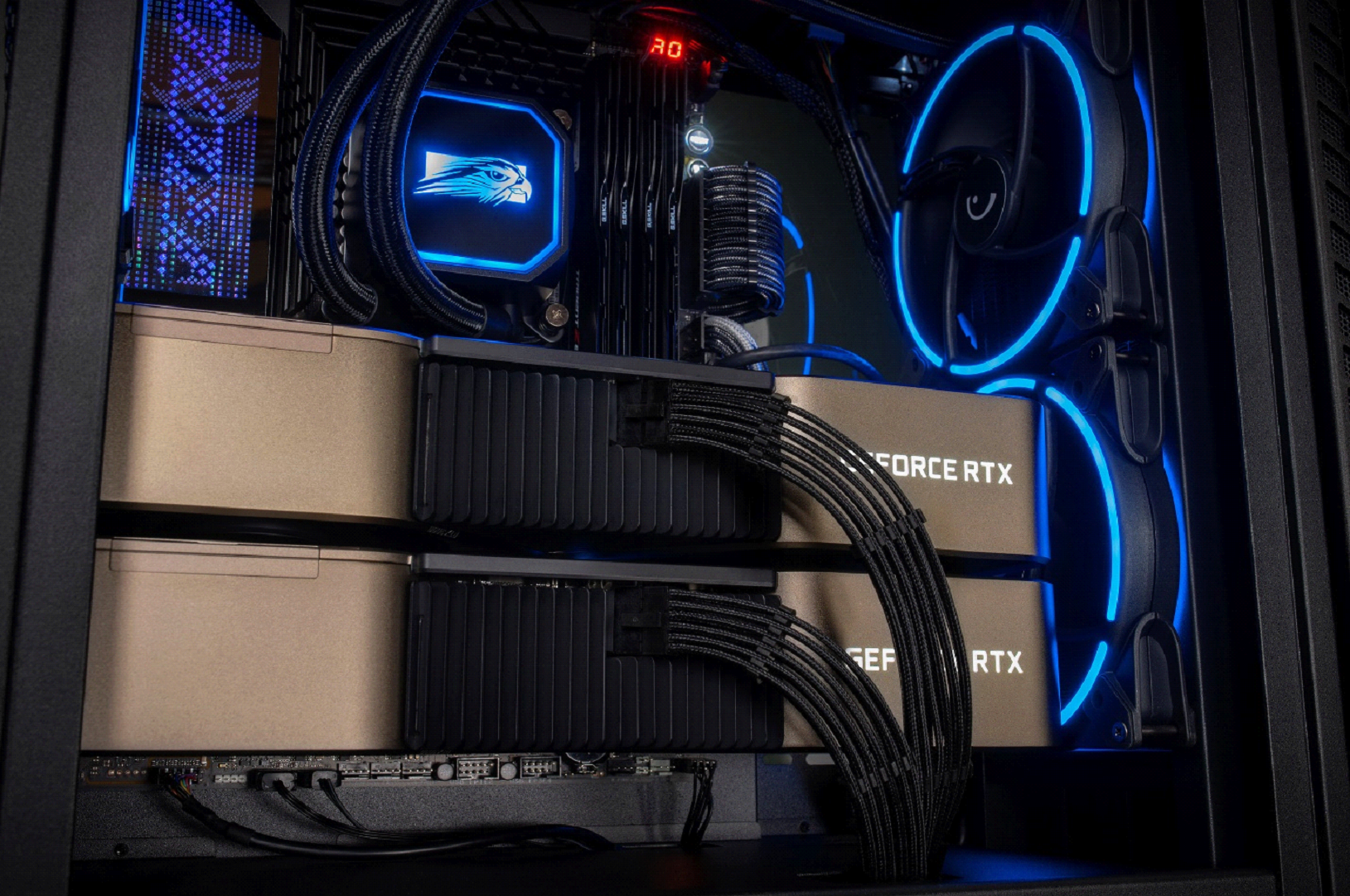 In the early 2000’s a certain competitor of yours sold computers with a mouse, monitor, and keyboard that were all color matched. These days, Apple appears to be the only player offering this with their 24” iMac lineup. Has Falcon Northwest considered color matching configurations now that you offer UV prints or is there not enough of a market for that?
In the early 2000’s a certain competitor of yours sold computers with a mouse, monitor, and keyboard that were all color matched. These days, Apple appears to be the only player offering this with their 24” iMac lineup. Has Falcon Northwest considered color matching configurations now that you offer UV prints or is there not enough of a market for that?
Unfortunately UV printing can’t be done on curved surfaces so things like mice wouldn’t be possible. Also, peripherals like mice and keyboards are such a personal-preference item. There are hundreds of choices out there and we don’t carry a lot of them because of that. We’re far from the days when your choices were a Logitech or a Microsoft.
What was that light bulb moment where you decided that Falcon Northwest should sell a SFF chassis? Outside of the FIC Ice-Cube IC-VG61, was there another chassis that you had considered?
I’d seen the difficulty people had schlepping their “big rigs” into and out of LAN parties, which were a big thing for gamers pre-internet. Shuttle was the new dominant force in SFFs at the time. I loved the form factor, but Shuttle just didn’t make anything with a high-end graphics card. There were not many other options than FIC back then you could even add in a graphics card to.
A few times in the past, Falcon Northwest builds have included custom hardware, some of which was unbeknownst to buyers at the time, like offering the fastest BFG Asylum 6800 Ultras on the market. Does Falcon Northwest still do this? Current landscape aside, has offering this sort of “leg up” over the competition become harder to do in recent years or is it downright impossible? We’ve seen TankGuys and SiliconLottery exit the binning market, and so it seems that only Vince “K|ngp|n” Lucido is binning hardware these days, unless we are missing something…
They’re extremely rare, but occasionally we get access to some super-limited run hardware like a liquid-cooled Radeon 6900XT that was only available thru boutique system builders.
With AMD’s Threadripper CPUs pairing quite well with ASRock’s X399M Taichi mATX motherboard, was there ever a time where Falcon Northwest considered adding a Threadripper to the Fragbox?
We looked at it, but we couldn’t cool it in an SFF. Threadripper CPUs burn 280Watts, and the type of clientele that buys them do things like rendering that burns all 280 Watts for hours. It just didn’t make thermal sense for us.
We’re just one year shy of celebrating the 20th anniversary of the FragBox and sales of the 3rd gen FragBox have been taken down to prepare for the redesigned chassis. Do you have any tidbits that you would be willing to to share about the 4th generation FragBox? Perhaps some juicy details about its internal radiator?
Yes: we’re going to be able to cool 280 Watt CPUs in it.
Not content to give the FragBox all of the attention, it’s also worth mentioning that your Tiki chassis was released 10 years ago as the very first console sized gaming micro-tower using all industry standard parts (11.7 liters). This is an impressively compact case that was designed and released a full 5 years before we saw anything like it. On Twitter, you recently announced a hardware refresh for the Tiki chassis without having to increase the size so from all of us here at Smallformfactor.net, we thank you. That’s right, #14 is not a question, just a thanks for keeping the Tiki so small after all of these years.
Thanks! We’re really proud of the thermals we achieved on the Tiki without having to make it bigger. And of how it can handle both the new “flow thru” airflow design of the new Founders Edition GPUs, as well as triple-axial fan designs. As for staying “console-sized”, if these consoles get any bigger…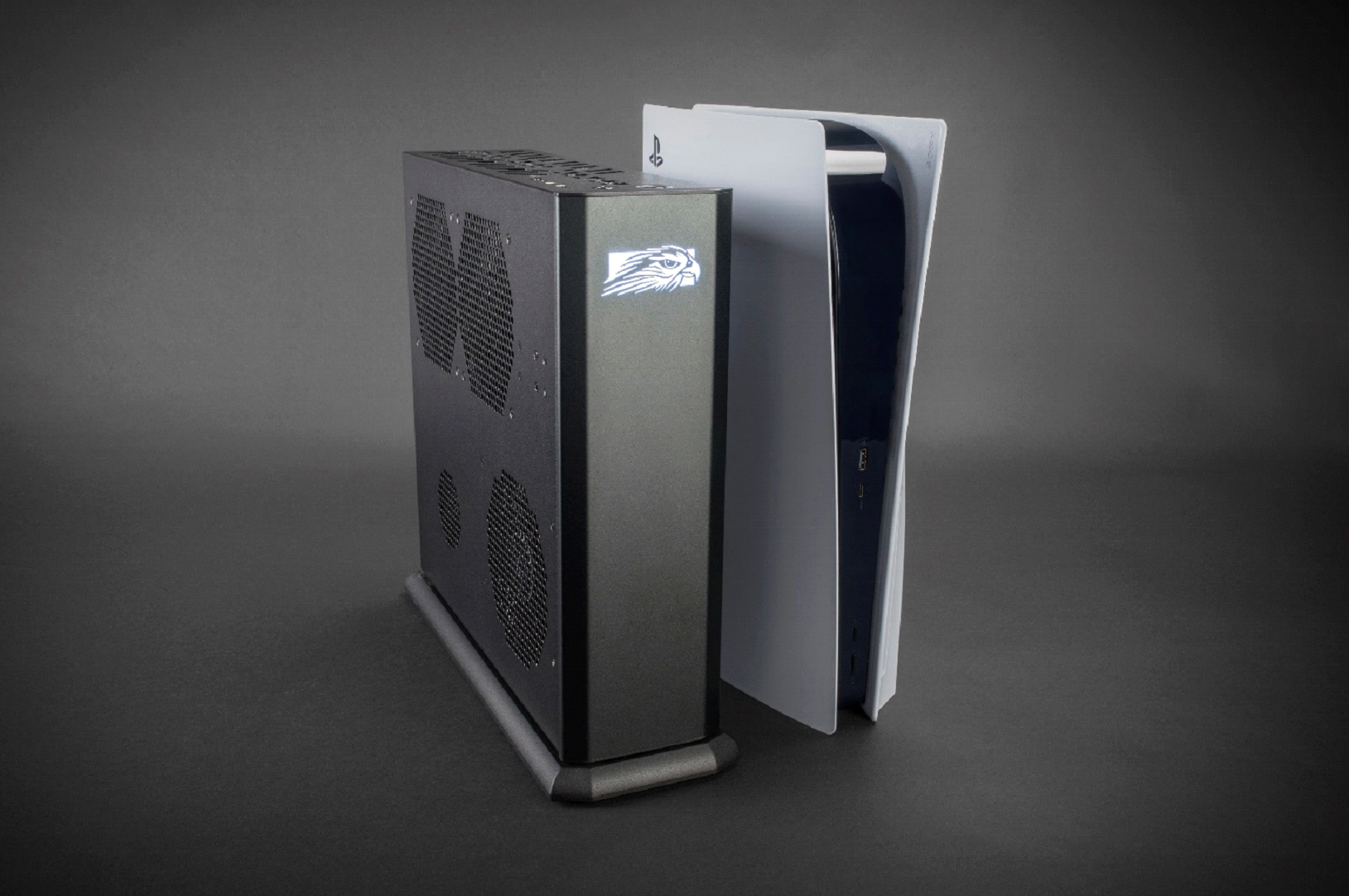 Thank you so much for your time Kelt, we really appreciate all that you have done for the gaming community, both LFF and SFF, and we especially appreciate your willingness to answer a few questions for us today.
Thank you so much for your time Kelt, we really appreciate all that you have done for the gaming community, both LFF and SFF, and we especially appreciate your willingness to answer a few questions for us today.
Thank you!

